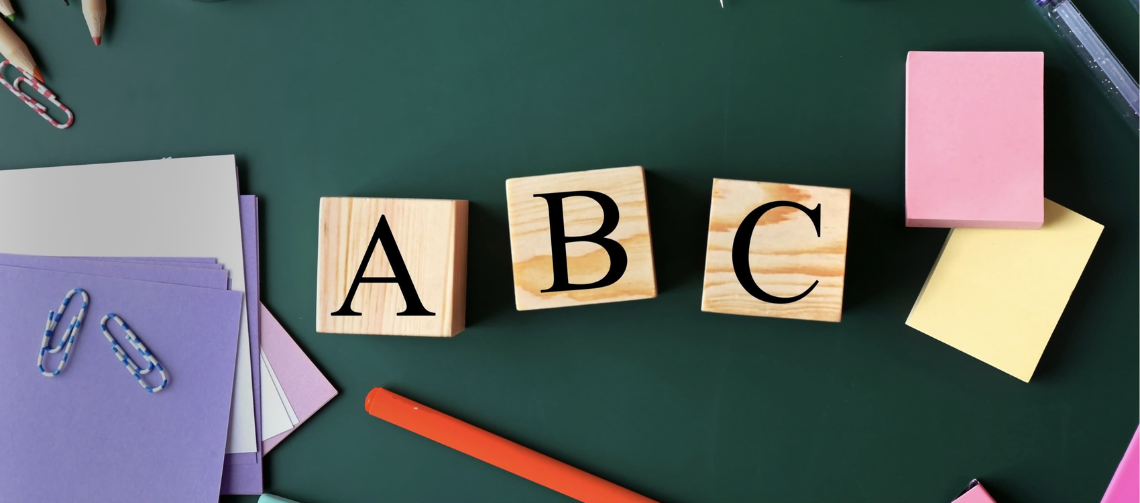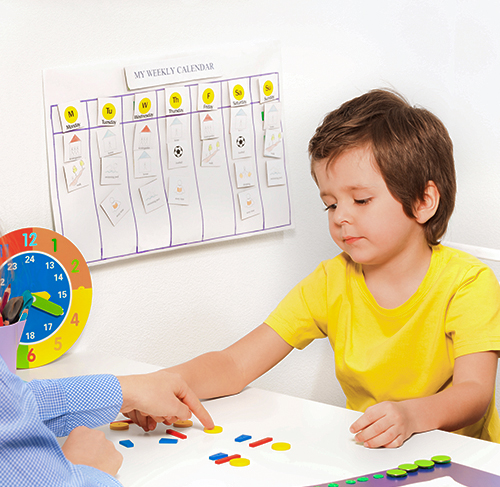Applied Behavior Analysis, or ABA, is a science that utilizes the principles of behavior to determine treatments to improve the socially significant behavior of individuals. ABA practitioners use the ABCs of ABA to design these treatments and implement them. Every ABA practitioner should be well-trained in identifying the ABCs of ABA.
What does A-B-C stand for?
The “A” stands for antecedent. An antecedent is anything that changes or occurs in the environment that happens prior to a behavior. When practitioners are observing a behavior of interest, it is not only important to measure the behavior but also to determine what event preceded it. More specifically, if a student engages in aggression, practitioners will record that the individual received a worksheet prior to the behavior. If aggression often happens after demands are placed, practitioners can use this information to create interventions.
The “B” in A-B-C represents the behavior. Behavior is anything that a living organism does. The behavior is what practitioners are trying to decrease or increase. In the previous example, aggression would be the behavior of interest.
Finally, “C” represents the consequence. A consequence refers to the event that occurs following the behavior of interest. The word “consequence” can have negative connotations and sometimes has been noted to be used interchangeably with punishment. However, this is incorrect because a consequence is simply what happens after the behavior, positive or negative. If a student shows aggression and the teacher removes the worksheet, that removal is the consequence.
Understanding Behavior in Children with Autism
For children with autism, behaviors often serve a purpose even if they seem confusing at first. Some specific behaviors, like hand-flapping, avoiding eye contact, or crying during transitions, can reflect sensory needs, communication struggles, or frustration. By focusing on understanding behavior through the ABC model, parents and therapists can identify what the child is trying to express. This helps create strategies that build communication and reduce stress for both the child and family.
The Role of Positive Behavior and Behavior Modification
ABA is not just about decreasing challenges—it is equally about encouraging positive behavior. Practitioners use reinforcement, such as praise or rewards, to help children learn skills like sharing, asking for help, or waiting patiently. Over time, these reinforcements shape stronger desired behaviors and reduce reliance on less effective responses. This process is called behavior modification, and it creates long-term growth by replacing old patterns with healthier alternatives.
The Importance of Identifying the ABCs
Identifying the ABCs of ABA in an event allows practitioners to hypothesize about the function, or reason, the behavior is occurring. By determining the function, practitioners can develop individualized strategies to reduce maladaptive behaviors. This process is called an ABC analysis.
The first step of conducting an ABC analysis is identifying the behavior the practitioners are targeting for decrease. Once the behavior is identified and defined, the antecedent and consequence can be recorded. Referring to the example of the student engaging in aggression, the most common antecedent is a task being placed and the most common consequence is the teacher removing the task. Using the information gathered from the ABC analysis, a practitioner can hypothesize that the student is engaging in aggression to escape from the task.
A treatment plan can be implemented where the teacher continues to place the demand of the worksheet even after the occurrence of aggression. This would combat the escape component of what is maintaining the behavior of aggression. An antecedent intervention could also be implemented where the teacher can let the student know prior to the presentation of the work that once they finish the worksheet, they can receive a toy or a break. This may increase the motivation of completing the work and decrease aggression.
Functions of Behavior and the ABC Model
When looking at the ABC model, it is not enough to know what happened before and after a behavior. We also need to understand why the behavior is happening. In ABA, this “why” is called the function of behavior.
There are four common functions:
- Escape: A child may act out to avoid something hard, like a school assignment.
- Attention: Some actions are a way to get someone to look, talk, or react.
- Access to tangibles: A child may cry or grab when they want a toy or snack.
- Automatic or sensory: Sometimes the action simply feels good, like hand-flapping.
By combining functions of behavior with the ABC framework, therapists can design plans that address the root cause instead of just the surface problem.
Clearing Up Common Misconceptions
Many people think the word “consequence” always means punishment. In the ABC model, a consequence is simply what happens after a behavior. It can be positive, neutral, or negative.
Another common myth is that ABC analysis is only used for “bad” behavior. In reality, the method is just as useful for building positive skills. Parents, teachers, and therapists can use it to teach sharing, waiting, or asking for help.
It is also important to remember that behavior never happens “for no reason.” Even if it feels random, there is almost always a trigger or payoff that can be identified through ABC data collection.

ABC Data Collection in Practice
Tracking behaviors is a critical step in ABA. Practitioners use data collection tools such as checklists, tally marks, or electronic charts to document the antecedent, behavior, and consequence. This information is often called ABC data. Collecting it over time allows patterns to become clear—such as when a child is more likely to resist work or seek attention. These insights guide the development of interventions that are tailored to the child’s needs.
Real-Life Examples of the ABC Framework
This behavior framework shows up in many settings, not only in therapy rooms. Here are some examples:
- At school: A student may put their head down when asked to start math. The antecedent is the teacher’s request, the behavior is putting their head down, and the consequence might be getting out of the task.
- At home: A child may throw a tantrum when the TV is turned off suddenly. The antecedent is the TV being turned off, the behavior is the tantrum, and the consequence is the parent turning the TV back on.
- In the community: A child might yell loudly in the grocery store aisle. The antecedent is being denied candy, the behavior is yelling, and the consequence could be the parent buying the candy.
Implementing the ABC Model at Home
While therapists use the ABC framework in sessions, families can also benefit from implementing the ABC at home. Parents might notice that their child often refuses dinner when the TV is turned off suddenly. By adjusting the antecedent (giving a 5-minute warning before turning off the TV) and reinforcing desired behaviors (praising the child for sitting calmly at the table), parents can create smoother routines. This real-world use of the ABC model helps carry over therapy strategies into daily life.
Challenges in Using the ABC Model
Although this framework is powerful, there are challenges too. Sometimes it is hard to spot the true antecedent if the trigger happened earlier in the day. Other times, the consequence is delayed, which makes the link harder to see.
Another challenge is observer bias. Two people may see the same event but describe it differently. For this reason, ABA professionals train families and teachers on how to write clear, simple notes when collecting ABC data.
Even with these challenges, the ABC model remains one of the most effective tools for understanding and guiding behavior.
Things You Should Know About ABA
Get the must-know facts about Applied Behavior Analysis—all in one guide
Free downloadParent Training in Behavior Analysis
ABA professionals often include parents in learning the ABC model. Parent training helps families notice what comes before a behavior and how to respond after.
For example, a parent might learn to give a warning before turning off the TV, instead of doing it suddenly. They may also learn to praise calm behavior instead of giving in to a tantrum.
With practice, families feel more confident in handling daily struggles. This makes therapy progress carry over into home life and strengthens the child’s long-term growth.
An ABC analysis takes several days to be conducted, and examples such as this one is not always as clear. Sometimes behaviors seem to “come out of nowhere.” If you are a practitioner of ABA, this is never the case. ABA practitioners know that the universe is lawful, and behaviors do not happen spontaneously by completing an ABC analysis, the reasons behind why behaviors are occurring can be hypothesized. By determining the potential reason for maintaining behaviors, practitioners can develop a more cohesive and individualized treatment plan for their clients.
Case Example: Bringing It All Together
Consider a child who often refuses homework. At first, parents may see this as simple defiance. But through ABC analysis, a clearer picture emerges:
- Antecedent: Parent places homework on the table.
- Behavior: Child throws the pencil and cries.
- Consequence: Homework is removed.
In this case, the function is escape. A therapist may suggest keeping the homework on the table but offering a small break or reward for finishing it. Over time, the child learns to complete the task without aggression.
This simple example shows how the ABC model can turn daily struggles into learning opportunities.
Cooper, J. O., Heron, T. E., & Heward, W. L. (2014). Applied behavior analysis. Harlow: Pearson.
Learn more about ABA intervention here. Follow us on Facebook, Instagram, LinkedIn, and Twitter to stay on top of our latest updates.









Leave A Comment